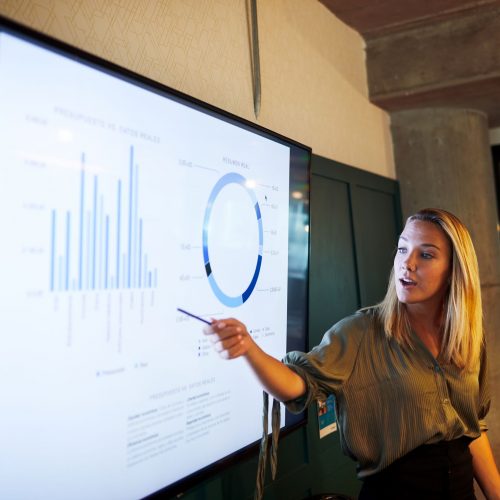Context and policy overview
Vienna is regularly ranked as the city that offers the world’s best quality of life.[1] It also has a tradition of strong governance and engagement with residents in constructive, participatory dialogue.
While Vienna’s employment rates and average incomes are high, the region and the city face environmental challenges, including pollution of the Danube River due to unsustainable development along its banks and increasing air pollution due to private transport.[2]
Against this background, in June 2014 Vienna’s city council adopted the Smart City Wien Framework Strategy (SCWFS), a comprehensive scaffold for developing effective responses to climate change, including radical conservation of resources and productive use of new technology. Projects that have emerged from the strategy include, for instance, an initiative for e-car-sharing.[3] The strategy was updated in 2019 to incorporate the UN Sustainable Development Goals and to reflect the increased urgency of addressing climate change.[4]
There was concern that such a complex, long-term framework would develop actions that would be left by the wayside among the daily pressing agendas of local government. Therefore, the city council required the municipal administration to undertake a periodic monitoring programme and to verify at regular intervals that the framework’s objectives were being met.[5] This monitoring was intended to serve as a performance management tool for policymakers and to support the city in implementing and updating the strategy.
Vienna recognised that to back this monitoring process and make the strategy more transparent, the city would need to establish a central data platform. This had to cover the entirety of the municipal administration and ensure access for residents and the exchange of information. In this way, it would involve all of the main stakeholders in the implementation of the SCWFS.
Two principles were defined for the monitoring approach. First, there would be extensive cooperation across city departments and associated organisations to maximise support and ownership. The second key principle was to minimise the data collection workload for participants and to focus on analysing the existing data pool and reporting structure.
Implementation
Vienna created the SCWFS in 2013, following two years of stakeholder engagement and the City Council Resolution of 2014 which first stipulated the need for a monitoring process.
The initial step was to conduct an extensive exploratory project to establish a methodology for monitoring that would reflect the objectives of the SCWFS. The first monitoring process took place in 2017 as part of an EU-funded project and consisted of:
- monitoring objectives by evaluating them individually based on an extensive set of indicators
- carrying out overall monitoring of the Framework’s results.
One-third of the objectives could be measured quantitatively. However, the remaining objectives posed greater challenges as their measurement required extensive qualitative descriptions. In these cases, individual indicators were grouped together, making it possible to assess a subject area in more general terms.
Some of the indicators used by the city were found to require greater precision before they could provide a more comprehensive picture, although Vienna recognises that evaluation of indicators should be an ongoing process.
The monitoring is a resource-heavy and timeconsuming process, exacerbated by the absence of a central overview of the city’s data. Indeed, centralised access to the Vienna’s data pools has been identified as an area for future improvement. This could be achieved through further improvement to the online reporting tool already in place and by providing access for the entire municipal authority.
An additional evaluation is expected to take place in order to make the process more routine.
The monitoring programme’s key success factor was its integration of evaluation with the strategic performance management cycle for the overall framework. This ensured that the findings could be fed back in more effectively.
The division of tasks across a multitude of stakeholders according to their areas of expertise (data provision, for instance) was supported by academic institutions. This approach ensured ownership and reduced the administrative burden on local government.
Results and lessons learned
The city’s monitoring process involved particpants from across the municipality and stakeholder organisations. These organisations took different roles in the process, from reporting on goals to providing objective evaluation and data. This illustrates the methodology’s effective approach of engaging a multitude of stakeholders, thus creating ownership of the framework.[6]
One feature of Vienna’s implementation framework is the Smart City Agency, which is responsible for coordinating activities under the framework.[7] An agency of this kind is a key ingredient in the successful implementation of smart city strategies.[8]
The monitoring provided evidence-based findings on progress against individual objectives and showed where the city needed to make further progress. For example, the assessment identified that Vienna’s CO2 reduction target for 2030 had almost been achieved just one year after the framework was launched. Although this was a positive finding, the monitoring also identified persistent social disadvantages in access to green space. Some measured outcomes of the SCWFS as detailed in the 2017 monitoring report include:
- a reduction in per capita GHG emissions of 33 per cent in 2014 relative to a 1990 baseline (this is a headline goal, with the reduction of GHG emissions being the strategy’s prime objective)
- a fall in per capita energy consumption since 2005, of around 14 per cent
- growth in the share of renewable energy, from 12.1 per cent in 2010 to 19.5 per cent in 2015.
Using the monitoring framework to not only report achievements, but to put these in the context of progress against an eventual target, ensures a longterm view and identifies the scale of further actions required. For example, the 2017 monitoring report identified successes and good progress against some targets, but also areas of stagnation or poor performance, for instance:
- levels of car traffic have stagnated since 2013, and Vienna is not on track to meet its objectives to shift to other modes of transport
- similar stagnation or fluctuation in the trends for environmental indicators in buildings and in the water and waste sectors suggests that efforts are required to remain on track, or get back on track.
The accountability offered by a monitoring process has been shown to have a tangible impact on the fulfilment of a city’s strategy. Moreover, in Vienna, the data collection necessary to complete the monitoring and evaluation in a smart way was built on existing databases and enabled the creation of a new online reporting tool.

















